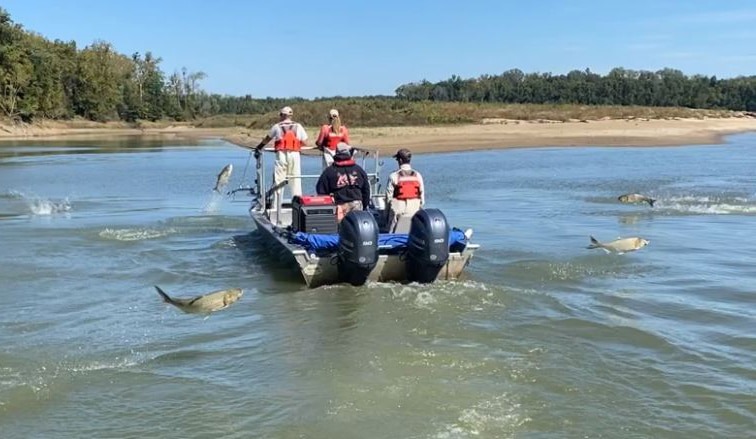
By Randy Zellers for the Arkansas game and Fish Commission
CLARENDON, Arkansas — The Arkansas Game and Fish Commission and U.S. Fish and Wildlife Service’s Lower Mississippi River Fish and Wildlife Conservation Office in Tupelo, Mississippi, recently tested a new method of fish sampling on the White River that may help monitor the fight against invasive carp. The electrified dozer trawl method streamlines two previously used sampling techniques to collect information on the populations of silver and bighead carp, two invasive species the AGFC is working to reduce in Arkansas waters.
Previously, biologists would slowly motor through an area and use electricity to stun fish while simultaneously dipping them from the water using long-handled dip nets.
“Dip netting those giant carp can be extremely difficult for the person on the front of the boat,” Matt Horton, Aquatic Nuisance Species Coordinator for the AGFC, said. “You also have some variability between how good different ‘dippers’ are that can make it difficult to get consistent numbers between sampling events.”
The ‘fishdozer’ takes that variability out of the equation. Instead of people using dip nets, a device called a push trawl is lowered into the water. The trawl looks like a blade of a bulldozer that’s been hollowed out and outfitted with a length of netting as a catch bag that flows underneath the hull of the boat. As fish are stunned by the electric field, the boat cruises over them, securing them in the net like a whale swallowing krill.

According to Jimmy Barnett, Invasive Carp Biologist for the AGFC, the dozer testing was conducted in three different scenarios along the White River to determine its effectiveness in varying aquatic habitats. Researchers are testing the experimental gear throughout the Mississippi River Basin to modify the design and technique to optimize carp capture and identify where it is most effective.
Standardized sampling methods are necessary to estimate fish abundance. Horton says the AGFC and its partners may be able to more accurately measure the effectiveness of carp removal efforts in some bodies of water using the dozer trawl.
The sampling technique doesn’t have immediate use as a fish removal strategy, but Barnett mentions that with some modifications, the tool may have some applications to help control these invasive fish.
“We performed both active netting with gill nets and the electrified dozer trawl in Cook’s Lake, which lets us compare the two,” Barnett said. “Gill nets produced 200 adult silver carp versus 78 collected with the dozer trawl, but we did see that the trawl collected mostly fish in the juvenile size ranges up to about 8 pounds. We use gill nets that have large webbing to reduce the amount of nontarget fish we catch, so catching carp smaller than 10 to 12 pounds is pretty rare with our current netting protocol.
“I wouldn’t say this gear is as efficient as other methods for removing carp, but it may provide managers with another tool for monitoring the distribution and abundance of carp and evaluate the effectiveness of control efforts.”
Visit www.agfc.com/ANS for more information on aquatic nuisance species like invasive carp.




